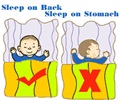The risk of dying from Sudden Infant Death Syndrome and other sleep-related causes within the first year was highest for those born between 24 and 27 weeks.
Highlights
- Infants born between 24 and 27 weeks of gestation are at greater risk of dying from sudden infant death syndrome and other sleep-related infant deaths.
- To bring down the //growing number of cases due to SIDS, the American Academy of Pediatrics released new recommendations in 2011 and 2016.
- Besides unsafe sleep practices, other causes for infant mortality include smoking, poor prenatal care and poverty.
Incidence of SIDS
- SIDS comprises approximately 20%-25% of deaths in infants younger than 1 year.
- The majority of the SIDS deaths occur between the ages of 2-4 months, with ninety percent of all cases occurring before six months of age.
- In the United States, a baby dies every three hours due to an unexplained cause or due to suffocation with a soft object.
- More male babies succumb to SIDS in comparison to girls.
Ostfeld and co-author Thomas Hegyi, professor of pediatrics at Robert Wood Johnson and medical director of the SIDS Center of New Jersey, published a study in Pediatrics which found that infants born between 24 to 27 weeks had a more than three times higher chance than babies born full term of dying before their first birthday of a sudden unexpected infant death, which is comprised of SIDS and other sleep-related infant deaths.
The risk was high, according to researchers, even when factors, including smoking and inadequate prenatal care, were taken out of the equation. While the level of risk decreased for premature infants born closer to full-term, they were still significantly higher, according to the study.
Recommendations to Prevent SIDS
Since 1992, parents have been advised by pediatricians to put their babies to sleep on their backs, and never on their stomachs. Incidence of SIDS have since then declined by 43 percent.
New recommendations were released again in 2011 and 2016 to address SIDS other sleep-related deaths - 25 percent of which are caused from suffocation, entrapment and asphyxia which have increased. The AAP also recommended keeping infants in a consumer product safety commission approved crib, bassinet or portable crib near the parent's bed.
"It's important that neonatal intensive care units assess how well they are complying with these guidelines and teaching about safe infant sleep practices," said Ostfeld. "Pediatricians need to remind parents and grandparents at every office visit."
Educate Parents To Comply to Recommendations
Ostfeld said researchers need to develop more evidence-based interventions for increasing compliance with safe sleep practices, and also need to address potentially treatable intrinsic factors that elevate risk for the preterm infant.
Besides unsafe sleep practices, other causes for infant mortality include smoking, poor prenatal care and poverty, she said.
Based on the most recently available national data, New Jersey has the lowest rate of sudden unexpected infant deaths in the nation."The extensive statewide education programs conducted by the SIDS Center of New Jersey in collaboration with its many partners have contributed to these improvements," Ostfeld said.
Reference
- Barbara Ostfeld et al., Premature infants at greater risk of SIDS, Pediatrics (2017).
Source-Medindia











